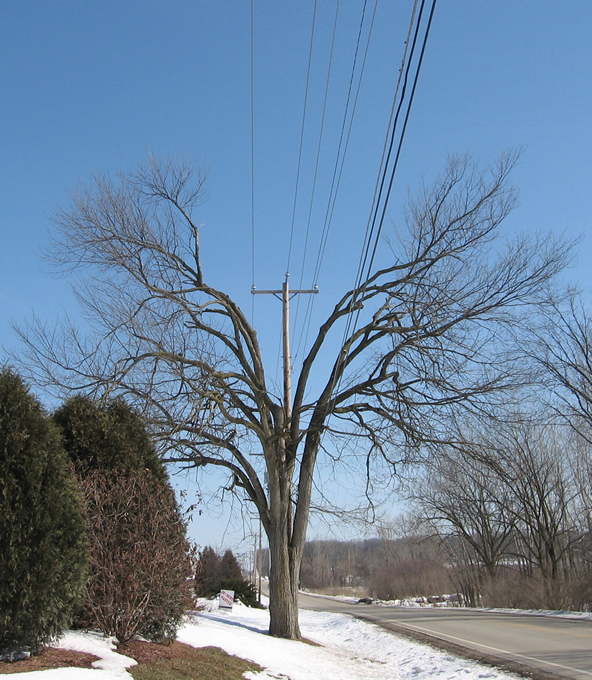Electric lines in contact with trees can be dangerous. Contact can cause power outages, fires and other safety hazards. The risk increases when severe weather brings lightning, ice or high winds. For reliability and compliance with the National Electric Safety Code, we prune or cut down trees that threaten electric service. We determine a schedule each year for areas that require trimming and re-evaluate those plans as needs change throughout the year. We trim to get adequate separation between trees and power lines.
If you are concerned about trees making contact with power lines, call us at 800-242-9137. A forester will visit your property to evaluate the situation and inform you whether trimming is needed to maintain safe, reliable service. If you are planning to remove or trim a trees on your own, review our guidelines.
Tree trimming safety guidelines
Our trimming practices
How and when we trim, depends on the type of line. Several types of lines share utility poles, including electric, cable and phone.
Diagram of service lines on a typical utility pole
How and when we trim, depends on the type of line
- High-voltage primary lines: Cleared based on the species and location of trees. Our tree trimming contractors follow guidelines set by the International Society of Arboriculture and the Tree Care Industry Association.
- Service and secondary lines: These wires are designed to be more resistant to tree contact. We trim branches that prevent service wires from hanging freely, or we add sleeves to service wires to prevent tree damage. Before you or your contractor trim or remove trees close to service lines (pole-to-home wires), call 800-242-9137 to ask us to turn off power. We turn off electricity temporarily and restore it when your work is complete — at no charge.
- Cable/phone lines: We do not trim trees for these facilities. Contact your phone or cable company if you are concerned about tree contact.
Directional pruning
Directional pruning removes entire branches and limbs from the tree trunk. This technique directs future growth away from power lines, reduces re-growth and protects the tree from decay while preserving as much beauty as possible. Crews remove trees only when the hazard is severe and are cut as close as possible to grade. We do not remove stumps. The image below shows a tree with directional pruning.

Tree topping
We avoid tree topping because topped trees can quickly regain their original height, and the large number of fast-growing sprouts are susceptible to breakage and storm damage.
Species and location of trees
All trees are pruned back to existing tree lines. If no tree line exists, the trees are classified as either slow-growing or fast-growing and pruned as follows:
- Slow-growing tree species: Pruned to provide at least 6 feet of clearance from side of line.
- Fast-growing tree species: Pruned to provide 10 feet of clearance from side of line.
- All limbs hanging over lines: Pruned to provide 20 feet of clearance above line.
Trees that must be cut down
Typically we prune trees, but we must cut down trees at times.
- All tall-growing trees smaller than 12 inches in diameter within 10 feet of a high-voltage primary line will be cut down.
- All hazardous, diseased, structurally weakened or leaning trees that pose an imminent threat to the line will be cut down, and debris will be left on site.
- Trees that have caused repeated safety problems or power outages will be cut down.
- Stumps and young, tall-growing trees are treated with an herbicide to prevent regrowth. (Note: Stumps will not be removed.)
Brush removal
Reliability work
You own the trees on your property, so most debris removal is your responsibility. Our crews clean up the area after work is complete, but what we remove depends on size and location. In unmaintained areas, limbs and brush are piled and left on-site. In maintained areas, limbs are chipped and taken away. Large tree trunks and stems are left on-site in both maintained and unmaintained areas.
- Maintained: Typically a residence with landscaping and a mowed yard.
- Unmaintained: Wooded, natural or wild areas.
Invasive species
Debris from all invasive species will be left on-site, per Wisconsin Department of Natural Resources.
Invasive Species Rule — NR 40
Lawn cleanup
Contractors use best practices to minimize damage to property. If damage is caused by the contractor, the contractor will pay for the cost to return your property to its original condition.
Free wood chips
As a result of our line clearance program, wood chips may be available upon request. To recycle our wood chips as completely and efficiently as possible, we deliver only full truckloads to when in your area.
Free wood chips
Storm restoration work
When storms occur, we mobilize our crews to restore your power. Often, we remove fallen trees and broken limbs only to the point where we can restore power safely and quickly. We are not able to assist in removing debris from yards. Contact your municipality for storm cleanup information.